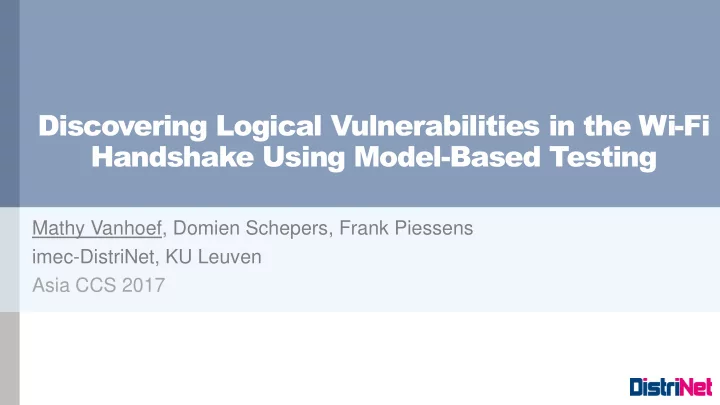

Discovering Logical Vulnerabilities in the Wi-Fi Handshake Using Model-Based Testing Mathy Vanhoef, Domien Schepers, Frank Piessens imec-DistriNet, KU Leuven Asia CCS 2017
Introduction More and more Wi-Fi network use encryption: 2010 Most rely on the Wi-Fi handshake to generate session keys 2
How secure is the Wi-Fi handshake? Design: formally analyzed and proven correct (CCS 2005) Security of implementations? Some works fuzz network discovery stage Many stages are not tested, e.g. 4-way handshake. But do not tests for logical implementation bugs Objective: test implementations of the full Wi-Fi handshake for logical vulnerabilities 3
Background: the Wi-Fi handshake Main purposes: Network discovery Mutual authentication & negotiation of pairwise session keys Securely select cipher to encrypt data frames WPA-TKIP AES-CCMP Short-term solution that sacrificed Long-term solution based on some security, so it could run on modern cryptographic primitives old WEP-compatible hardware 4
Wi-Fi handshake (simplified) 5
Wi-Fi handshake (simplified) Defined using EAPOL frames 6
EAPOL frame layout (simplified) … header key info replay counter MIC key data P M I S E R C A key version key info flags ≈ message ID 7
EAPOL frame layout (simplified) … header key info replay counter MIC key data P M I S E R C A key version key info flags MD5/RC4 ≈ message ID or SHA1/AES 8
How to test implementations? Model-based testing! Test if program behaves according to some abstract model Proved successful against TLS Apply model-based approach on the Wi-Fi handshake 9
Model-based testing: our approach Test generation rules Handshake Set of test A test case defines: model cases 1. Messages to send 2. Expected replies Correct & incorrect 3. Results in successful modifications Normal Set of test or failed connection? handshake cases For every test case Execute No (or unexpected reply) Test failed test case No Yes Reset Expected result? Successful connection? Expert determines exploitability! Inspect failed tests 10
Test generation rules Test generation rules manipulating messages as a whole: 1. Drop a message 2. Inject/repeat a message Test generation rules that modify fields in messages: 1. Wrong selected cipher suite in message 2 2. Bad EAPOL replay counter 3. Bad EAPOL key info flags (used to identify message) 4. Bad EAPOL key version (switch SHA1/AES with MD5/RC4) 5. Bad EAPOL Message Integrity Check (MIC) 6. … 11
Evaluation We tested 12 access points: Open source: OpenBSD , Linux’s Hostapd Leaked source: Broadcom, MediaTek (home routers) Closed source: Windows, Apple, Telenet Professional equipment: Aerohive, Aironet Discovered several issues! 12
Missing downgrade checks 1. MediaTek & Telenet don’t verify selected cipher in message 2 13
Missing downgrade checks 1. MediaTek & Telenet don’t verify selected cipher in message 2 2. MediaTek also ignores supported ciphers in message 3 MediaTek clients can be trivially downgraded 14
Windows 7 targeted DoS Client AP Client 2 … 15
Broadcom downgrade Broadcom cannot distinguish message 2 and 4 Can be abused to downgrade the AP to TKIP Hence message 4 is essential in preventing downgrade attacks This highlights incorrect claims in the 802.11 standard §11.6.6.8: 4-way handshake analysis mentions that: “ While Message 4 serves no cryptographic purpose , it serves as an acknowledgment to Message 3. It is required to ensure reliability and to inform the Authenticator that the Supplicant has installed the PTK and GTK and hence can receive encrypted frames. ” 16
Other results: see paper! Fingerprinting techniques! Permanent DoS attack against OpenBSD & Broadcom DoS attack against Windows 10, Broadcom, Aerohive Inconsistent parsing of selected and supported cipher suite(s) … 17
Conclusion Overall advantages and disadvantages: Black-box testing mechanism: no source code needed o But time consuming to implement & requires an expert Detected several issues, for example: Missing checks allowing downgrade attacks Several implementation-specific flaws … Fairly simple handshake, but still several logical bugs! 18
Discovering Logical Vulnerabilities in the Wi-Fi Handshake Using Model-Based Testing Mathy Vanhoef, Domien Schepers, Frank Piessens Questions?
Recommend
More recommend